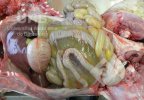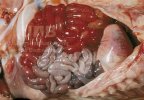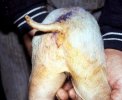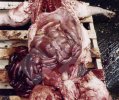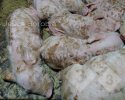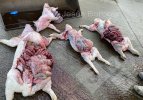Clostridium perfringens
Diseases caused by Clostridium perfringens appear as a chronic or acute enteritis in piglets. In some cases in growing and adult animals you can also have a disease characterized by gangrene and / or cellulite with sudden death.
Alternative names: Clostridial diseases, Clostridium perfringens type A, Clostridium perfringens type C, necrotic enteritis
Information
Diseases caused by Clostridium perfringens appear as a chronic or acute enteritis in piglets.
Clostridia are Gram positive bacteria of a great size, which produce spores. It is present in the intestine of all pigs. They multiply at a great speed and produce toxins which quickly kill the host. The disease caused by C. perfringens type A is milder, less dramatic and lasts longer, but it can be similar to the disease caused by C. perfringens type C.
The species of C. perfringens, types A or C can, under certain conditions, produce severe diarrhea with high mortality in piglets. Type C is by far the most important. If it enters the small intestine and gets established in it before the piglets consume colostrum, they can get the disease. Piglets usually get infected before 7 days of age, mainly during the first 24-72 hours. Type C can become a chronic disease in piglets from 2 to 6 week old.
It is present in soil and in the intestine of all pigs. When deep wound or tissue trauma occurs, the organism if present can multiply quickly and produces toxins that produce gas and kill the host very rapidly.
Symptoms
Sows, weaners and growers
- Sudden death.
- Painful swelling of muscle mass and discoloration of these structures.
- Gangrene.
Lactating piglets
- Bloody diarrhea
- Diarrhea in piglets 0 to 21 days old.
- Necrosis in the small intestine mucosa; the mucosa is shedded and it can also be observed in the diarrhea.
- In chronic cases, the small intestine mucosa can be thickened.
- High mortality.
- Air bubbles in small intestine.
- Anorexia /weight loss.
Causes / Contributing Factors
- High number of bacteria in the environment, especially sow's faeces.
- Unknown factors.
Diagnosis
- Clinical sigs and post mortem lesions.
- Direct smear staining of intestinal mucosa.
- Culture.
- PCR genotyping.
Control/Prevention
Sow
- Clostridium is very sensitive to penicillin.
- Vaccinate sows 3 and 5 weeks before farrowing.
Piglets
- In acute outbreaks it can be useful to administer antiserum to the piglets when they are born.
- During acute outbreaks, administer oral antibiotics.
- Sow’s feed can be medicated during 14 days before farrowing to minimize contamination of environment at farrowing.
- Washing sows before placing in clean farrowing room.
- Proper cleaning and disinfection of farrowing room.
Growing pigs
- Clostridium is very sensitive to penicillin.
- Vaccinate growing pigs in area where gangrene/cellulitis is of concern.
Atlas of pathology
See images in the Altlas related to Clostridium perfringens

